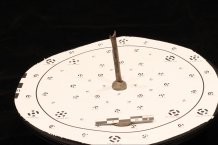
View a 3D model of the Fishbourne Rabbit Tibia bone here: https://skfb.ly/6GMGH
Britain’s earliest bunny found at Roman palace
Experts have found the remains of Britain’s earliest rabbit - a discovery which reveals bunnies arrived in the country 1,000 years earlier than previously thought.
Rabbits are native to Spain and France. It had been thought they were a medieval introduction to Britain, but this fresh discovery has pushed that timing back by more than a millennium.
Radiocarbon dating of the bone, which was unearthed at Fishbourne Roman Palace in Sussex, show the rabbit was alive in the 1st century AD.
The 4cm segment of a tibia bone was found during excavations in 1964 but it remained in a box, not recognised, until 2017, when Dr Fay Worley, zooarchaeologist at Historic England realised the bone was from a rabbit, and genetic analyses have proved Fay was right.
Britain’s earliest rabbit doesn’t bear any butchery marks, and another analysis suggests it was kept in confinement. The inhabitants at Fishbourne Palace were known to be wealthy and kept a varied menagerie, so the rabbit could have been an exotic pet.
Essential scientific analysis means the bone can no longer be handled, but visitors to Fishbourne this week can see a 3D print of it, as well as take part in other rabbit themed fun including an Easter hunt and on Good Friday, readings from an upcoming children’s book about the different Easter animals. If you can’t visit in person, you can view a 3D model of the bone on this site: https://skfb.ly/6GMGH.
Academics from the University of Exeter, Universities of Oxford and Leicester, and funded by the Arts and Humanities Research Council, carried out the analyses, together with Historic England and Sussex Archaeological Society. Further research is ongoing that will reveal where the rabbit came from and whether it is related to modern bunnies
Professor Naomi Sykes, from the University of Exeter, who is leading the work, said: “This is a tremendously exciting discovery and this very early rabbit is already revealing new insights into the history of the Easter traditions we are all enjoying this week. The bone fragment was very small meaning it was overlooked for decades, and modern research techniques mean we can learn about its date and genetic background as well.
“We are looking forward to telling people about our ongoing research this week. There’s a lot we don’t know about the origins of Easter, and we’re learning more every day.”
Dr Fay Worley, zooarchaeologist at Historic England said: “I was excited to find a rabbit bone from a Roman deposit, and thrilled when the radiocarbon date confirmed that it isn’t from a modern rabbit that had burrowed in. This find will change how we interpret Roman remains and highlights that new information awaits discovery in museum collections!”
Katherine Warren, Strategy and Development Manager at the Arts & Humanities Research Council said “We are proud to support this research which not only encourages people to understand the origins of our Easter traditions but also the evolution of animal populations in the UK.”
Easter is the most important event in the Christian calendar, yet very little is known about when it first appeared in Britain. Although there is an abundance of popular belief and folklore, we also know next to nothing about the origins of Easter customs, such as the gifting of eggs purportedly delivered by the Easter ‘bunny’
The research team is using evidence from anthropology, (zoo)archaeology, (art) history, evolutionary biology, law, historical linguistics, natural history and religious studies to try to work out where and when modern Easter traditions first began and when they arrived in Britain.
The English word Easter was first documented in the eighth century AD by the Venerable Bede, whose treatise On the Reckoning of Time refers to spring celebrations in honour of the pagan goddess Ēostre, from whom Easter takes its English and German name. The first historical mention of an “Easter Bunny” is in fact an Easter hare, and is found in a German text from 1682.
It is not clear how, when or why the rabbit became linked to the Easter festival, although it could be due to the spread of Christian religious beliefs.
Date: 18 April 2019
